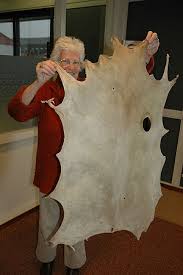Parchment is thin skin of calves, cows (: vellum, also used for drums or as window pane), goats, sheep (: pergamenum), rabbits or donkeys; rarely horses and pigs.
 Parchment has a thickness of about 0.6 mm on average.
Parchment has a thickness of about 0.6 mm on average.
The skin was soaked several weeks long in water to make it soft and clean.
Eight days in thick lime water (formerly dog dung) laying, which makes hair and meat residues come loose (in winter to 2 weeks). Stir certainly 2x/day.
Scraping hair remains and flesh or fat leftovers. Stretch the skin.
Again scraping and polishing with pumice and chalk (to absorb moisture).
It was cut to size (possibly glued together) and on a stick rolled into a scroll (Latin: volume), or folded into a book quire (folded sheet of a number of pages (usually a multiple of four) sewn to each other.) That was called a codex (bound book, in contrast to scroll).
Wind protector of thin grinded and oiled parchment (or a pig bladder).

